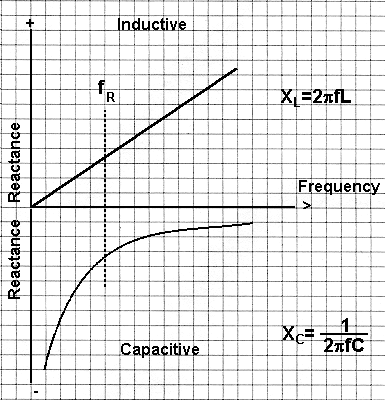|
|
||||||||||||
|
|||||||||||||
Before we get into the explanation of the syllabus here is some introduction to the topic. Resonance
If we have a simple circuit of an inductor, capacitor and resistor linked in series and apply an AC voltage not only is there resistance due to the resistor but also due to the capacitor and the inductor.
Reactance is the oppositions to current flow in an AC circuit, so it can be thought of as AC resistance. This resistance however is caused by capacitors and inductors so to differentiate from "normal" resistance we call that caused by the capacitor Capacitance Reactance and that by an inductor Inductive Reactance.
Now with a LOW frequency being applied
at
When the frequency being applied
at
It should therefore be apparent to you that at some frequency between these too extremes of low and high that the Capacitive Reactance and the Inductive Reactance will equal each other. Further because the voltage drop across the inductor and the capacitor are not only equal but 180o out of phase they cancel each other out. At the point of Capacitive Reactance and the Inductive Reactance cancelling each other out, the only opposition to the current flow in the circuit will only be the resistor. Let's have a look at what we have just said in graph form. If we draw the graphs of Capacitive Reactance and the Inductive Reactance on a common frequency line we get :-
Conclusion We can now answer the question posed at the top of the page :- What is Resonance and where can it be found ?
Resonance is that moment when the changing
frequency of an oscillator reaches a frequency when applied to a tuned circuit
the Capacitive Reactance and the Inductive Reactance are equal. It can be
found easily from plotting a graph as shown above at a frequency of
Drinks break time !!! I hope you are ok so far, as this is very heavy going relative to the Foundation and to the Intermediate Licence courses, so if I were you I would take a break here have some of your favourite drink, or something, and then come back to it again refreshed.
|
|||||||||||||
|
|||||||||||||
|
|||||||||||||













